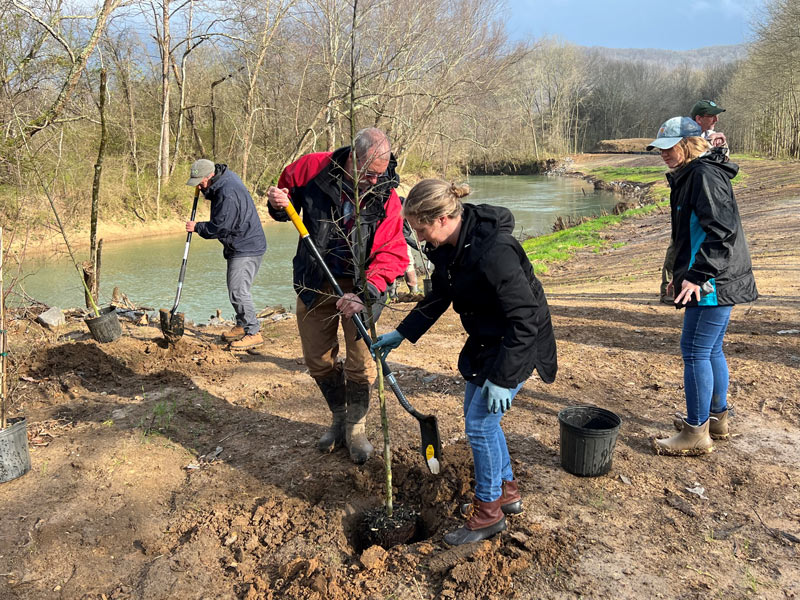Articles
Protecting a Biodiversity Hotspot
Alabama’s Most Diverse Watershed Gets a Makeover
Nestled between forested mountains in Alabama is Paint Rock River, a tributary to the Tennessee River.
Despite its small size, Paint Rock is home to 98 fish species and 59 mussel species, 12 of which are listed as endangered or threatened under the Endangered Species Act.
To help protect this biodiversity hotspot, TVA has partnered for many years with The Nature Conservancy, other non-governmental organizations, federal and state agencies, and private landowners to restore Paint Rock River’s riparian zone, which includes the lands adjacent to the river. This restoration aims to improve the watershed’s water quality.
“The collaborative efforts of organizations in this watershed serve as an example of conservation at all levels to reach long-term improved water quality and aquatic species habitat benefits,” said Shannon O’Quinn, TVA senior water conservation specialist.

TVA’s Natural Resources team joins partners to celebrate several successful bank restoration efforts with a tree planting event.
Restoring Riparian Zones
Restoring riparian zones is made possible through stream bank stabilization.
The process starts by flattening an eroded stream bank. Then, matting is placed on the newly formed slope. Vegetation is planted in the final step. The plants beside a stream, located in the riparian zone, serve critical roles in the health of streams. Towering trees and shrubs provide shade with their leaves, which cools the water and allows it to hold more oxygen. When leaves, branches, and downed trees crash into the water, they provide food and shelter to fish.
“Once those trees in the riparian buffer get established, those roots will go all through the bank, preventing it from eroding away again,” O’Quinn said.
Eroded soil can smother fish and cut off light to underwater plants. When it finally settles, it covers the rocky streambed, a vital part of the aquatic habitat.
During the past two years, 1,050 linear feet have been restored along the Paint Rock watershed, and two upcoming projects are scheduled to restore an additional 1,000 feet.
Monitoring and More
Paint Rock River is one of 500 streams across TVA’s service area where fish communities are monitored.
By observing these populations, TVA identifies water quality issues and shares the data with The Nature Conservancy and other conservation partners. O’Quinn noted that the watershed is already a healthy one, and continued monitoring will help protect it.
Among the aquatic life in the Paint Rock are 59 mussel species that serve as a filter to help keep streams and rivers clean of heavy metals, harmful algae, and bacteria. Two of those mussels are the pale lilliput and the Alabama lamp mussel, which are found nowhere else in the world.
“This small northeast corner of Alabama has more aquatic species than the entire state of California,” said Alana Reynolds, watershed coordinator for the freshwater program at The Nature Conservancy in Alabama.
In addition to monitoring, education plays a vital role in protecting the Paint Rock watershed.
During conservation projects like riparian zone builds, TVA and its partners teach landowners about stream ecology and federal incentive programs.
“Best management practices help farmers prevent their property from being eroded away,” O’Quinn said. “Something as simple as installing a fence to keep cattle out of a creek helps aquatic life because the sediment isn’t making it to the stream."
Restoration efforts also involved the removal of aquatic barriers, allowing aquatic life to move freely up and down the stream.
TVA worked with the U.S. Fish and Water Wildlife Services and the Nature Conservancy in Jackson County to replace Estill Fork Bridge, a low-water bridge. The bridge was a barrier to aquatic life, and because it tended to flood, it was a safety issue for residents in the local community. The replacement is a single-span bridge that allows fish and people to travel freely.
“The work that has been completed in the Paint Rock watershed has been so successful that The Nature Conservancy is using it as a model to complete conservation work in other priority watersheds within the state,” Reynolds said.